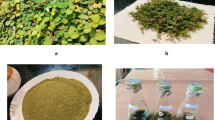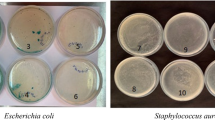Abstract
An attempt has been made in this paper to investigate antimicrobial property of glycyrrhiza extract on cotton fabric. Uniform glycyrrhiza powders were obtained by superfine grinding. The particle size distribution of powders was mostly around 1 μm. Effects of ultrasonic on dispersion capability of glycyrrhiza powders were investigated. With the extension of ultrasonic time the value of zeta potential decreased significantly from −22 to −31 mV. Flavanone compounds which exhibit inhibitory effects against multiple viruses were extracted by ethanol from superfine glycyrrhiza powders. Qualitative and quantitative methods were used to test the antibacterial properties of the fabrics treated by glycyrrhiza extract. The results showed that the inhibition rates against S. aureus and E. coli were 81.75 and 73.81 % respectively indicating that the finished fabrics exhibited good antibacterial property. It retained about 30 % of its inhibition to S. aureus after 10 cycles of laundering. However, the fabrics treated with sol of glycyrrhiza exhibited more resistance to washing with 71.43 % inhibition rate after 5 times washing. The whiteness index of glycyrrhiza exact treated fabrics decreased from 93.28 to 90.22 % indicating that glycyrrhiza exact had little influence on the whiteness of fabrics.
Similar content being viewed by others
References
Y. Yang, L. Corcoran, K. Vorlicek, and S. Li, Text. Chem. Color Am. Dyestuff Rep., 32, 48 (2000).
A. Vishnu and K. Bhagyashri, Man Made Textiles in India, 3, 89 (2010).
H. S. Seong, J. P. Kim, and S. W. Ko, Text. Res. J., 69, 483 (1999).
B. Kausik, C. Ishita, B. Ranjit, and B. Uday, Current Science, 82, 1336 (2002).
S. Usha and S. J. Laxmikant, Colourage, 53, 129 (2006).
R. K. Sarkar, D. Purushottam, and P. D. Chauhan, Man Made Textiles in India, 2, 44 (2002).
T. Kim and S. Young, Dyes Pigments, 64, 85 (2005).
S. Y. Han and Y. Q. Yang, Dyes Pigments, 64, 157 (2005).
T. Ramachandran, R. Lakshmanan, M. Natarajan, and S. Karthikeyan, Man Made Textiles in India, 1, 15 (2010).
S. Amsamani and V. Krishnaveni, Man Made Textiles in India, 4, 145 (2007).
S. X. Xue, X. M. Chen, J. X. Lu, and L. Q. Jin, Carbohyd. Polym., 75, 415 (2009).
Z. G. Wang and J. Ren, Trends Pharmacol. Sci., 23, 347 (2002).
J. Ren and P. Liang, Carbohyd. Polym., 72, 858 (2008).
Z. Nowakowska, Eur. J. Med. Chem., 42, 125 (2007).
H. Watanbe, C. Miyaji, M. Makino, and T. Abo, Biotherapy, 9, 209 (1996).
T. Pengsuparp, L. Cai, H. Constant, H. H. Fong, L. Z. Lin, A. D. Kinghorn, J. M. Pezzuto, G. A. Cordell, K. Ingolfsdottir, and H. Wagner, J. Nat. Prod., 58, 1024 (1995).
J. W. Critchfield, S. T. Butera, and T. M. Folks, AIDS Res. Hum Retroviruses, 12, 39 (1996).
Y. C. Hou, S. L. Hsiu, H. Ching, and Y. T. Lin, Life Sci., 76, 1167 (2005).
J. Cinatl, B. Morgenstern, G. Bauer, P. Chandra, H. Rabenau, and H. W. Doerr, The Lancet, 361, 2405 (2003).
A. Ruiz and P. B. Nagy, Ultrasonics, 42, 665 (2004).
A. V. Nguyen, P. George, and J. Graeme, Chem. Eng. Sci., 61, 2494 (2006).
R. A. Dixon, P. M. Dey, and C. J. Lamb, Enzymol, 55, 1 (1983).
Author information
Authors and Affiliations
Corresponding author
Rights and permissions
About this article
Cite this article
Lv, F., Li, Y., Chen, S. et al. Skin friendly antimicrobial characterization of natural glycyrrhiza extract on fabric. Fibers Polym 15, 1873–1879 (2014). https://doi.org/10.1007/s12221-014-1873-5
Received:
Revised:
Accepted:
Published:
Issue Date:
DOI: https://doi.org/10.1007/s12221-014-1873-5




